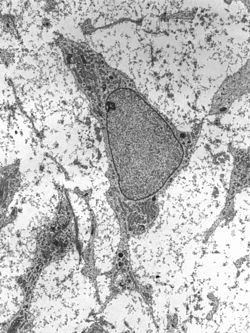Structure and Classification of Mesenchymal Stem Cells
- MSCs are characterised by a small cell body with long and thin cell processes.
- The terms 'mesenchymal stem cell' and 'marrow stromal cell' have been used interchangeably.
- MSCs do not differentiate into hematopoietic cells.
- MSCs have roles in tissue repair.
- MSCs can be derived from various non-marrow tissues.
- The International Society for Cellular Therapy (ISCT) has proposed standards to define MSCs.
- MSCs show plastic adherent properties and have a fibroblast-like morphology.
- MSCs can undergo osteogenic, adipogenic, and chondrogenic differentiation.
- MSCs express specific surface markers and lack the expression of certain surface markers.
- Some argue that MSCs and fibroblasts are functionally identical.
Location and Function of Mesenchymal Stem Cells
- MSCs are found throughout the human body.
- Bone marrow is the most frequently utilised source of MSCs.
- Umbilical cord tissue and Wharton's jelly are rich sources of primitive MSCs.
- Adipose tissue is an easier and safer source of MSCs compared to bone marrow.
- The mandibular third molar tooth bud is a rich source of MSCs.
- MSCs have a great capacity for self-renewal and maintain their multipotency.
- Differentiation of MSCs into various cell types can be induced.
- MSCs may differentiate into neuron-like cells, but their functionality is uncertain.
- The differentiation capacity of MSCs varies among individuals and with age and culture time.
- MSCs have immunomodulatory effects and can suppress tumor growth.
Clinical Significance and Research on Mesenchymal Stem Cells
- Mesenchymal stem cells can be activated and mobilised in reaction to injury and infection.
- ClinicalTrials.gov lists more than 1,100 studies featuring MSCs for more than 920 conditions.
- MSCs are being investigated for their efficacy in treating autoimmune diseases, graft versus host disease, Crohn's disease, multiple sclerosis, systemic lupus erythematosus, and systemic sclerosis.
- Intravenous transplantation of MSCs has shown clinical success in systemic diseases such as graft versus host disease and sepsis.
- Further studies into the mechanisms of MSC action may provide avenues for increasing their capacity for tissue repair.
- Modern culture techniques for MSCs involve colony-forming unit-fibroblasts (CFU-F) approach or flow cytometry-based methods.
- STRO-1+ cells are a more homogenous population of MSCs with higher rates of adherence and proliferation.
- Immunodepletion techniques like MACS have been used for negative selection of MSCs.
- Basal media for MSC culture is often supplemented with fetal bovine serum or human platelet lysate.
- Various chemicals and methods, including low-level laser irradiation, have been used to increase the proliferation of MSCs.
- In the 1960s, the clonal nature of marrow cells was revealed by scientists Ernest A. McCulloch and James E. Till.
- Dr. Caplan identified conditions by which mesodermal cells differentiate into cartilage, myogenic tissue, and bone in 1970.
- The first clinical trials of MSCs were completed by Osiris Therapeutics in 1995 to test the safety of the treatment.
- The first regulatory approvals for MSCs were granted in 2012 in Canada, New Zealand, and Japan for treating specific conditions.
- Over 1,000 clinical trials have been conducted to treat numerous conditions using MSCs.
- The term 'mesenchymal stem cells' and the most scientifically correct meaning for the MSC initialism have been debated.
- Most MSC preparations only contain a minority fraction of true multipotent stem cells, with most cells being stromal in nature.
- Dr. Caplan proposed rephrasing MSCs to emphasize their role as medicinal signaling cells.
- The shorthand MSC has come to refer to mesenchymal stromal/stem cells due to the heterogeneous nature of cellular preparations.
- Concerns have been raised about the marketing and application of unapproved MSCs and mesenchymal stem cells by for-profit clinics.
Identification and Characterization of Mesenchymal Stem Cells
- PMID2071617: Discusses the case of mistaken identity between mesenchymal stromal cells and fibroblasts.
- Minimal criteria for defining multipotent mesenchymal stromal cells: The International Society for Cellular Therapy position statement.
- Comparison of adipose tissue-derived versus bone marrow-derived mesenchymal stem and stromal cells.
- Non-hematopoietic bone marrow stem cells: Molecular control of expansion and differentiation.
- Characteristics and clinical applications of Wharton's jelly-derived mesenchymal stromal cells.
Immunomodulatory Properties and Interactions of Mesenchymal Stem Cells
- MSCs inhibit monocyte-derived DC maturation and function by interfering with the generation of immature DCs.
- Inflammatory cytokine-induced intercellular adhesion molecule-1 and vascular cell adhesion molecule-1 in mesenchymal stem cells are critical for immunosuppression.
- Mesenchymal-stem-cell-induced immunoregulation involves FAS-ligand-/FAS-mediated T cell apoptosis.
- Mesenchymal stromal cell secretion of programmed death-1 ligands regulates T cell-mediated immunosuppression.
- Mesenchymal stem cells inhibit neutrophil apoptosis, preserving neutrophils in the bone marrow niche.
- Human mesenchymal stem cells inhibit differentiation and function of monocyte-derived dendritic cells.
- Immunobiology of mesenchymal stem cells.
- Mesenchymal stem cell-mediated immunosuppression occurs via concerted action of chemokines and nitric oxide.
- Human bone marrow stromal cells suppress T-lymphocyte proliferation induced by cellular or nonspecific mitogenic stimuli.
- Bone marrow mesenchym
Mesenchymal stem cells (MSCs) also known as mesenchymal stromal cells or medicinal signaling cells are multipotent stromal cells that can differentiate into a variety of cell types, including osteoblasts (bone cells), chondrocytes (cartilage cells), myocytes (muscle cells) and adipocytes (fat cells which give rise to marrow adipose tissue).
| Mesenchymal stem cell | |
|---|---|
 Transmission electron micrograph of a mesenchymal stem cell displaying typical ultrastructural characteristics. | |
| Details | |
| Identifiers | |
| Latin | Cellula mesenchymatica praecursoria |
| MeSH | D059630 |
| TH | H2.00.01.0.00008 |
| Anatomical terms of microanatomy | |